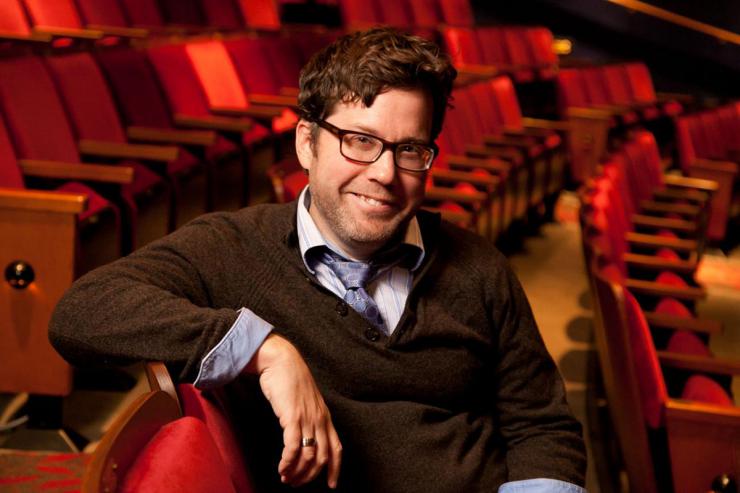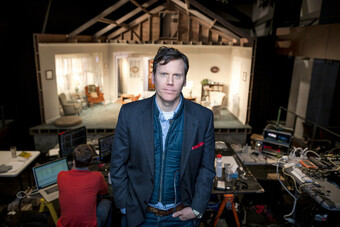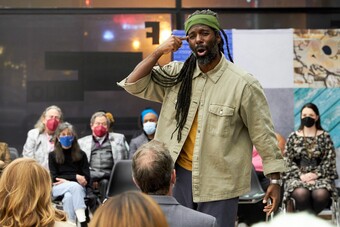Subversively Smart and Turning the Tide
Lauren Gunderson’s Women Heroes
I and You, which recently closed a well-received co-production from Merrimack Repertory Theatre (MRT) in Lowell, Massachusetts and Richard Winker at 59E59 in Manhattan, is not your typical teenaged girl yarn. Lauren Gunderson has created a flawed young woman protagonist who plays the lead in her own story.
Catherine (Kayla Ferguson) lives in a photo-adorned, computer dominated attic room, homebound by a serious illness. Classmate Anthony (Reggie D. White) visits with a task: to create the visuals and refine a class video presentation on Walt Whitman’s Leaves of Grass. As we watch the teens give their hearts and minds over to Whitman, wit and tender awkwardness leads to a deep connection between the two.

Over the phone, with playwright Lauren Gunderson in San Francisco and director Sean Daniels in New York, I discussed the play’s evolution and this production’s developments.
Daniels is unabashed in his appreciation of his friend Gunderson’s artistry in general and this play’s flawed and funny and smart and intriguing protagonist. “She is smart, she writes awkward people, which we all love to see on stage, and she has a real dedication to female characters and female stories that I don’t see anywhere else.”
Where I and You takes us into the world of a teenaged girl with a serious illness, many of Gunderson’s other plays are about history’s forgotten women who, because of when they were alive, lost their credit and legacy to men. For Daniels, Gunderson turns all this around.
At the center of it is a young woman struggling with what she thinks and what she believes, and that’s our hero. That’s what’s exciting about Lauren Gunderson. It just feels like she happens to have presented to us, over and over again, really compelling, interesting female characters that anybody can root for. That’s how she’s subversively smart and helping to turn the tide for all of us.
The National New Play Network (NNPN) rolling premiere, a series of collaboratively coordinated stagings that allow a playwright to continue work on a play through multiple full productions, deeply affected the development of this play in 2013 and 2014.
“It takes two full productions for me to get the play where I feel I’m ready to say publish or let go and give it its own life,” says Gunderson. “So that for me is really two rehearsal periods where that work is done.”

Gunderson is sold on this new-old idea of developing a play on the road. “I think it’s the best idea in American theatre right now,” she noted. Prior generations had the road trying out for Broadway and this is a new version of regional life for playmaking.
“We know that a play needs to grow,” she noted, “that’s not a new idea.”
Those out-of-town tryouts for Broadway, that’s how we used to do it. You would work it out of town and you would bring it into New York. And now, New York is one stop among many. It’s not the only stop for theatre. We can do that all over the country. It’s really this kind of beautifully simple idea that I’m so delighted has taken hold.
The 2014 Steinberg/ATCA New Play Award I and You won at the end of its NNPN rolling premiere provided a huge push for the play onto stages around the country. “All of the productions that play has seen and the publication in American Theatre magazine were more or less an outcome of that award.”
She says of winning the award,
It was one of the highest points in my career so far. That award is so special because of what it symbolizes on a bunch of levels. It comes from critics not just from one city but from across the country, and it’s about plays originating outside of New York.
Sean Daniels was raised in the DC area, and lived in Atlanta, Georgia for years, collaborating in the work of Dad’s Garage. It was in Atlanta that he first heard of Gunderson when she was a teenager doing monologues with a tape recorder that turned into dialogues. “Word had got out that there was this young, science playwright girl that everyone should go see.” The two became fast friends. Just a few months ago, Lauren performed Sean’s marriage ceremony.
It just feels like she happens to have presented to us, over and over again, really compelling, interesting female characters that anybody can root for. That’s how she’s subversively smart and helping to turn the tide for all of us.
Daniels has been at MRT for less than a year, and was able to program this current season with an almost forty-year-old company that is invested in new work. Their audience is “game for new work and subscribes before knowing the titles.” They traditionally have provided playwright third and fourth productions, which Daniels notes “is a very important place but not necessarily the sexiest place in the ecology of new plays.” He himself didn’t know the company well when he was approached for the job, and this was informative to him. “They had done the hard job, which is building up an audience that’s game for new work. But they hadn’t done the easy job, which is telling everyone about it and getting the word out to the national community.”

For Daniels’ first season, he had to “start off with a couple of shows that I knew epitomized the strongest writing that’s happening in the American theatre today. And that’s always Lauren Gunderson. That’s season planning that takes you five minutes.”
“I really want to give you your dream production,” he said to Gunderson, “with the people you’ve always wanted.” The male character Anthony was played at 59E59 by Reggie D. White, who had appeared in Gunderson’s Exit, Pursued by a Bear and was in Gunderson’s mind while writing the play, but hadn’t been successfully cast in any prior production. For Daniels, these were the opportunities they could provide. “Let’s get Reggie in and let’s give you a real top-notch design team.. It was about the same time that producer Richard Winkler reached out to Lauren and said he was interested in bringing the show to New York. So it was a real great confluence of events.”
Gunderson talks a lot about structure and architectural challenges in her plays. At the time she approached I and You, she’d written a number of history and science plays dealing with real lives and scientific inquiry. This play began with one of her managers posing a challenge: what if you wrote something contemporary? As she grappled with that, she added layers of challenge for fun: make it contemporary and between two people and have all action in one room. “How do I make something big and profoundly surprising and theatrical and beautiful, with all those large feelings that theatre can give us? How can I do that with all these parameters that seem to squeeze it into this compact thing?”
She knew from the beginning that his play would have a kind of Mousetrap element, that plot twist and surprise that would shock at first blush.
The original version at the Pacific Playwrights Festival at South Coast Rep, who commissioned it, was sixty pages long. I felt: I gotta get to the surprise, I gotta earn the surprise, I gotta get the engineering right. But the middle of the play, which is of course why you go see a play, the heart of it, is the thing that kept getting deeper and kept getting more risky and kept getting more character-based. I generally start knowing the ends of plays before I start writing them—it allows for the middle and the pulse of the play to be deepened and grow as the process does.
The story of I and You is simple on one level—two teens circling each other, trying to be heard. In fact, Gunderson doesn’t disabuse us of this idea. “Ideally,” she notes, “you could lop off the last five pages” and have a story that makes sense. Up to that point, we have a boy-meets-girl (or boy-invites-himself-to-a-girl’s-bedroom) story that doesn’t require discussing a plot development that everyone writing about the play has been asked to avoid. “The idea that the real change has already happened in the room, she has changed her heart, changed her mind, changed her perspective” is what excites Gunderson.
Gunderson’s focus on rhythm, pacing, language, and stage directions is addressed in her July/August 2014 American Theatre interview with Margaret Edson. Edson is curious about “word clumps” or compound words that are sometimes whole sentences in Gunderson’s script. Gunderson elaborates in our conversation: it’s about breath.
Pacing is so important. Certainly in things that have comedy to them, which all of my plays do. How I use the stage directions is to say to actors to keep the energy high and to keep picking up cues until there’s a pause. There’s a change in a pause, there’s something that’s so arresting that it makes you stop. You’re listening, you’re bouncing off, you’re talking, you’re moving, until something happens. And often that pause for me architecturally is the end of a fight, an argument, a besting, some sort of build that energetically drops us off a kind of cliff.
The power of the pause signifies the connections among the actors on stage. The change provides our reason for being in the room with these actors. “My architecture starts with: what’s the next change that we have to earn?”
You’re listening, you’re bouncing off, you’re talking, you’re moving, until something happens. And often that pause for me architecturally is the end of a fight, an argument, a besting, some sort of build that energetically drops us off a kind of cliff at that pause.
One of the lovely rewards of a simple and profound play like Gunderson’s I and You is that it plays with poetry in language and theatrical movement, and it rewards its audiences with a plotted and emotional reveal.
Gunderson brings our conversation back to the real emotional and dramatic climax of the play. Not, as she notes, any “coup de théâtre at the end,” but rather moments of connection, of two awkward teenagers reaching out to each other. “The real point, the whole point, the actual climax of the play is when Caroline runs to Anthony and hugs him. It’s that full body, totally not self-conscious, physical connection between them.”
“Taking a big thought, a big moment, and really giving it space to be beautifully theatrical is the point. I am an architectural playwright, and I love surprise, I think it’s so important if you can actually pull it off. Everyone loves a good surprise.”
Daniels has a vision for MRT: “To be a national theatre that has a strong local presence.” Toward that end, MRT has recently joined as an Associate Member of the NNPN, to join in the “rolling premiere” development of the next wave of new American plays.
Gunderson, meanwhile, is back to historical subjects in The Revolutionists, which premiered at Cincinnati Playhouse in the Park in February, and The Book of Will, a play about William Shakespeare’s friends and development of the First Folio, which was featured at the Denver Center New Play Summit.











Comments
The article is just the start of the conversation—we want to know what you think about this subject, too! HowlRound is a space for knowledge-sharing, and we welcome spirited, thoughtful, and on-topic dialogue. Find our full comments policy here